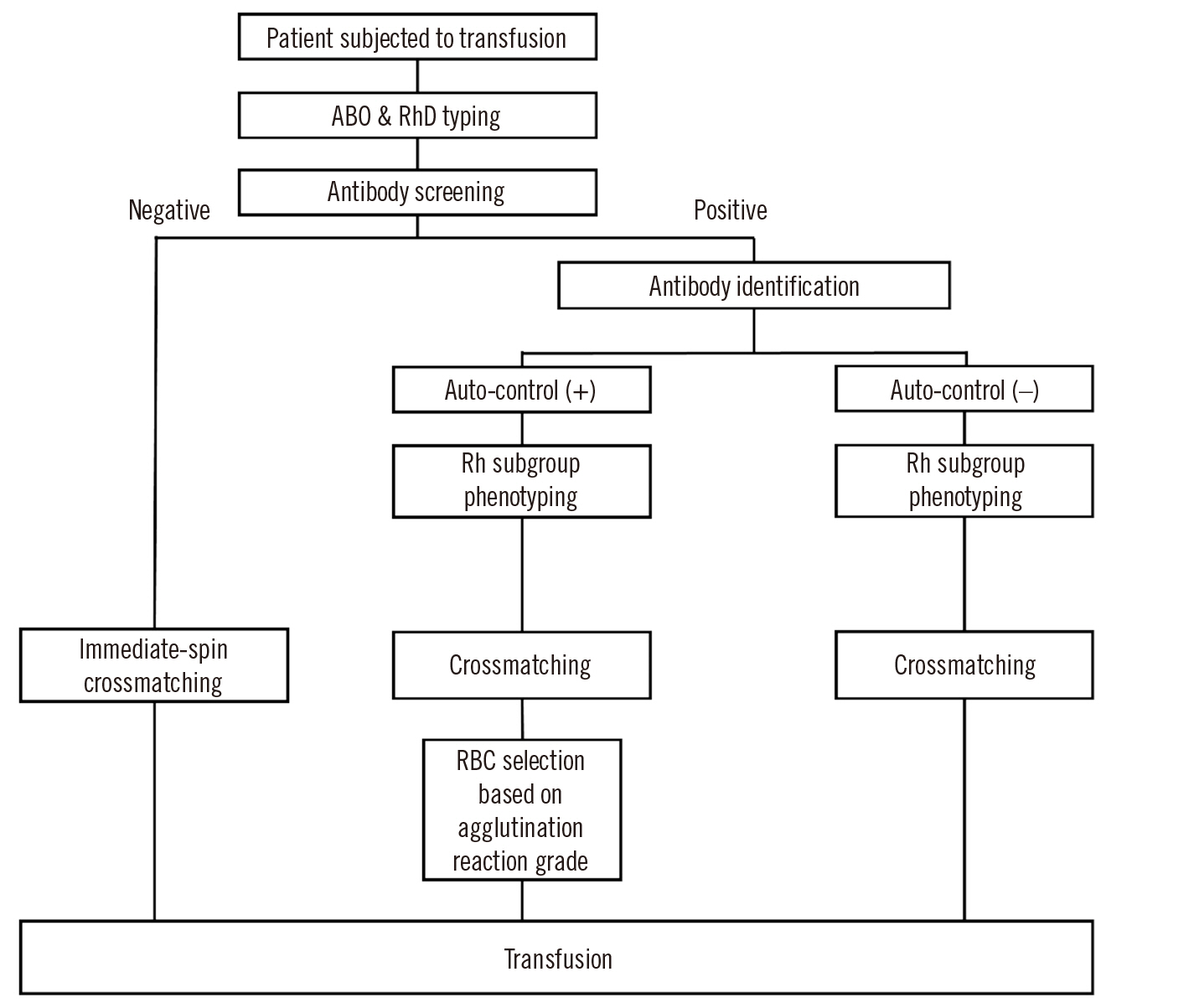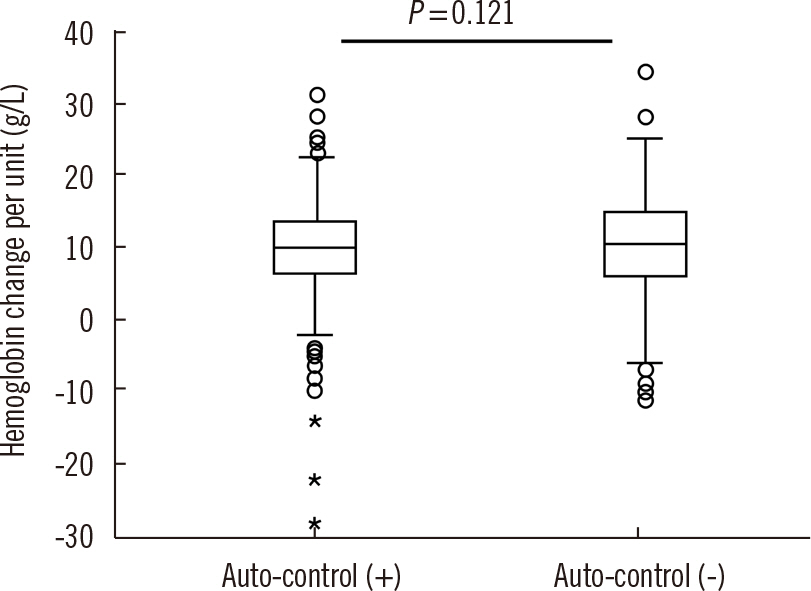Ann Lab Med.
2023 Sep;43(5):470-476. 10.3343/alm.2023.43.5.470.
Pre-transfusion Testing Using Crossmatching Agglutination Reaction Grades Combined With Rh Subgroup Phenotyping in Patients With Autoantibodies: A Three-year Experience at a Tertiary Hospital
- Affiliations
-
- 1Department of Laboratory Medicine, Pusan National University Hospital, Busan, Korea
- 2Biomedical Research Institute, Pusan National University Hospital, Busan, Korea
- 3Department of Laboratory Medicine, Pusan National University School of Medicine, Yangsan, Korea
- 4Biomedical Informatics Unit, Pusan National University School of Medicine, Yangsan, Korea
- 5Department of Laboratory Medicine and Research Institute for Convergence of Biomedical Science and Technology, Pusan National University Yangsan Hospital, Yangsan, Korea
- KMID: 2551995
- DOI: http://doi.org/10.3343/alm.2023.43.5.470
Abstract
- Background
The currently recommended pre-transfusion testing techniques for patients with autoantibodies are complex, time-consuming, and labor-intensive. Therefore, although the red blood cell (RBC) selection method using crossmatched RBC agglutination reaction grades (i.e., the “least incompatible” transfusion) is discouraged, many institutions still use it. We aimed to evaluate the effectiveness of this method combined with Rh subgroup phenotyping.
Methods
We retrospectively investigated RBC transfusions from January 2019 to December 2021 in patients presenting as auto-control-positive via antibody identification (auto-control (+) group), where Rh subgroup phenotype-matched RBCs were selected based on the agglutination reaction grades of crossmatched units. For each study patient, an auto-control-negative patient was matched based on age, sex, department, and pre-transfusion Hb levels (auto-control (−) group). The mean Hb change per unit, transfusion-associated symptom/sign reports, and agglutination reaction grades upon crossmatching were analyzed.
Results
In the auto-control (+) group, the Hb change per unit among different agglutination reaction grades of transfused RBCs and among different relative grades of transfused RBCs and crossmatching auto-controls was not significantly different (P=0.392 and P= 0.132, respectively). No significant difference was observed in Hb changes and transfusion-associated symptom/sign occurrence between the auto-control (+) and auto-control (−) groups (P=0.121 and P=0.822, respectively). In addition, no definite evidence of hemolysis in the auto-control (+) group was observed in the medical record review.
Conclusions
Together with Rh subgroup phenotyping, selecting the RBC unit with the lowest agglutination reaction grade upon crossmatching does not adversely affect transfusion efficiency.
Figure
Reference
-
1. Garratty G, Petz LD. 2002; Approaches to selecting blood for transfusion to patients with autoimmune hemolytic anemia. Transfusion. 42:1390–2. DOI: 10.1046/j.1537-2995.2002.00284.x. PMID: 12421209.
Article2. Salama A, Berghöfer H, Mueller-Eckhardt C. 1992; Red blood cell transfusion in warm-type autoimmune haemolytic anaemia. Lancet. 340:1515–7. DOI: 10.1016/0140-6736(92)92766-9. PMID: 1361607.
Article3. Petz LD. 2004; A physician's guide to transfusion in autoimmune haemolytic anaemia. Br J Haematol. 124:712–6. DOI: 10.1111/j.1365-2141.2004.04841.x. PMID: 15009058.
Article4. Ziman A, Cohn C, Carey PM, Dunbar NM, Fung MK, Greinacher A, et al. 2017; Warm-reactive (immunoglobulin G) autoantibodies and laboratory testing best practices: review of the literature and survey of current practice. Transfusion. 57:463–77. DOI: 10.1111/trf.13903. PMID: 27917465.
Article5. Reardon JE, Marques MB. 2006; Laboratory evaluation and transfusion support of patients with autoimmune hemolytic anemia. Am J Clin Pathol. 125:S71–7. DOI: 10.1309/ABP0B54GQL74L3KW. PMID: 16830958.
Article6. Leger RM, Garratty G. 1999; Evaluation of methods for detecting alloantibodies underlying warm autoantibodies. Transfusion. 39:11–6. DOI: 10.1046/j.1537-2995.1999.39199116889.x. PMID: 9920161.
Article7. Petz LD. 2003; "Least incompatible" units for transfusion in autoimmune hemolytic anemia: should we eliminate this meaningless term? A commentary for clinicians and transfusion medicine professionals. Transfusion. 43:1503–7. DOI: 10.1046/j.1537-2995.2003.00583.x. PMID: 14617306.
Article8. Park SH, Choe WH, Kwon SW. 2015; Red blood cell transfusion in patients with autoantibodies: is it effective and safe without increasing hemolysis risk? Ann Lab Med. 35:436–44. DOI: 10.3343/alm.2015.35.4.436. PMID: 26131416. PMCID: PMC4446583.
Article9. Chen C, Wang L, Han B, Qin L, Ying B. 2020; Autoimmune hemolytic anemia in hospitalized patients: 450 patients and their red blood cell transfusions. Medicine. 99:e18739. DOI: 10.1097/MD.0000000000018739. PMID: 31914091. PMCID: PMC6959959.10. Dwyre DM, Clapper A, Heintz M, Elbert C, Strauss RG. 2004; A red blood cell autoantibody with mimicking anti-E specificity. Transfusion. 44:1287–92. DOI: 10.1111/j.0041-1132.2004.04112.x. PMID: 15318850.
Article11. Issitt PD, Combs MR, Bumgarner DJ, Allen J, Kirkland A, Melroy-Carawan H. 1996; Studies of antibodies in the sera of patients who have made red cell autoantibodies. Transfusion. 36:481–6. DOI: 10.1046/j.1537-2995.1996.36696269503.x. PMID: 8669076.
Article12. Jang MJ, Cho D, Park KU, Yazer MH, Shin MG, Shin JH, et al. 2013; Autoantibodies with mimicking specificity detected by the dilution technique in patients with warm autoantibodies. Ann Lab Med. 33:343–8. DOI: 10.3343/alm.2013.33.5.343. PMID: 24003424. PMCID: PMC3756238.
Article13. Wheeler CA, Calhoun L, Blackall DP. 2004; Warm reactive autoantibodies: clinical and serologic correlations. Am J Clin Pathol. 122:680–5. DOI: 10.1309/CJAW6N8J6H0HR2WM. PMID: 15491963.
- Full Text Links
- Actions
-
Cited
- CITED
-
- Close
- Share
- Similar articles
-
- Acute Hemolysis Due to Rh Antibodies Against C and e Antigens after Rh-incompatible Transfusion in a Patient, Not Detected During Pre-transfusion Testing
- Advances in Pre-transfusion Testing and Immunohematology
- Discrepant Frequency of Rh Subtype and Kell Blood Group Antigens between Korean Pregnant Women and Their Neonates
- Autoantibodies with Mimicking Specificity Detected by the Dilution Technique in Patients with Warm Autoantibodies
- Rh C/c , E/e genotyping by polymerase chain reaction using sequence - specific primers



